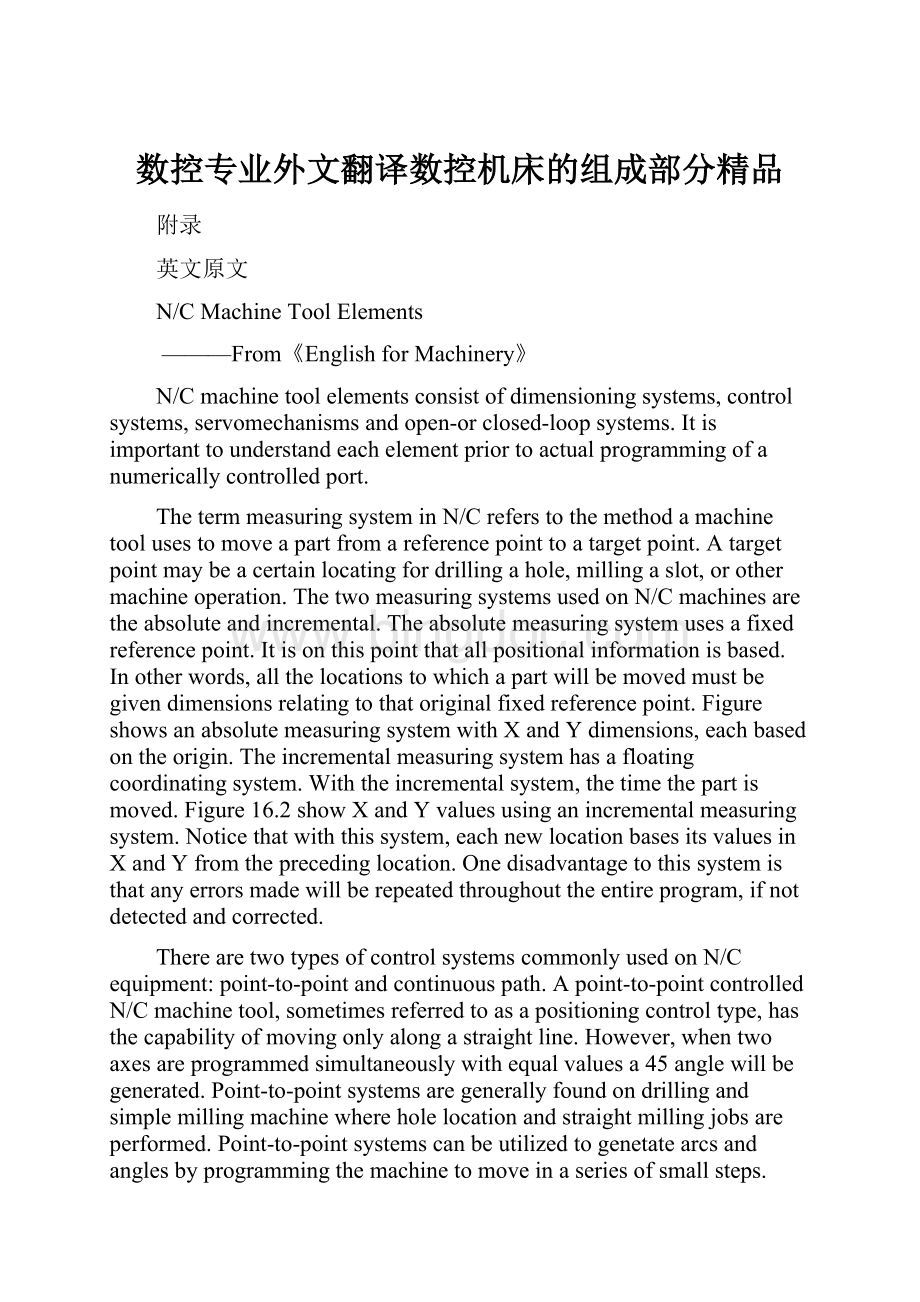数控专业外文翻译数控机床的组成部分精品.docx
《数控专业外文翻译数控机床的组成部分精品.docx》由会员分享,可在线阅读,更多相关《数控专业外文翻译数控机床的组成部分精品.docx(18页珍藏版)》请在冰点文库上搜索。

数控专业外文翻译数控机床的组成部分精品
附录
英文原文
N/CMachineToolElements
———From《EnglishforMachinery》
N/Cmachinetoolelementsconsistofdimensioningsystems,controlsystems,servomechanismsandopen-orclosed-loopsystems.Itisimportanttounderstandeachelementpriortoactualprogrammingofanumericallycontrolledport.
ThetermmeasuringsysteminN/Creferstothemethodamachinetoolusestomoveapartfromareferencepointtoatargetpoint.Atargetpointmaybeacertainlocatingfordrillingahole,millingaslot,orothermachineoperation.ThetwomeasuringsystemsusedonN/Cmachinesaretheabsoluteandincremental.Theabsolutemeasuringsystemusesafixedreferencepoint.Itisonthispointthatallpositionalinformationisbased.Inotherwords,allthelocationstowhichapartwillbemovedmustbegivendimensionsrelatingtothatoriginalfixedreferencepoint.FigureshowsanabsolutemeasuringsystemwithXandYdimensions,eachbasedontheorigin.Theincrementalmeasuringsystemhasafloatingcoordinatingsystem.Withtheincrementalsystem,thetimethepartismoved.Figure16.2showXandYvaluesusinganincrementalmeasuringsystem.Noticethatwiththissystem,eachnewlocationbasesitsvaluesinXandYfromtheprecedinglocation.Onedisadvantagetothissystemisthatanyerrorsmadewillberepeatedthroughouttheentireprogram,ifnotdetectedandcorrected.
TherearetwotypesofcontrolsystemscommonlyusedonN/Cequipment:
point-to-pointandcontinuouspath.Apoint-to-pointcontrolledN/Cmachinetool,sometimesreferredtoasapositioningcontroltype,hasthecapabilityofmovingonlyalongastraightline.However,whentwoaxesareprogrammedsimultaneouslywithequalvaluesa45anglewillbegenerated.Point-to-pointsystemsaregenerallyfoundondrillingandsimplemillingmachinewhereholelocationandstraightmillingjobsareperformed.Point-to-pointsystemscanbeutilizedtogenetatearcsandanglesbyprogrammingthemachinetomoveinaseriesofsmallsteps.Usingthistechnique,however,theactualpathmachinedisslightlydifferentfromthecuttingpathspecified.
Machinetoolsthathavethecapabilityofmovingsimultaneouslyintwoormoreaxesareclassifiedascontinuous-pathorcontouring.Thesemachinesareusedformachiningarcs,radii,circles,andanglesofanysizeintwoortheredimensions.Continuous-pathmachinesaremoreexpensivethanpoint-to-pointsystemsandgenerallyrequireacomputertoaidprogrammingwhenmachiningcomplexcontours.
N/Cservomechanismsaredevicesusedforproducingaccuratemovementofatableorslidalonganaxis.TwotypesofservosarecommonlyusedonN/Cequipment:
electricsteppingmotorsandhydraulicmotors.SteppingmotorservosarefrequentlyusedonlessexpensiveN/Cequipment.Thesemotorsaregenerallyhigh-torquepowerservosandmounteddirectlytoaleadscrewofatableortoolslide.Moststeppingmotorsareactuatedbymagneticpulsesfromthestatorandrotorassemblies.Thenetresultofthisactionisthatonerotationofthemotorshaftproduces200steps.Connectionthemotorshafttoa10-pitchleadscrewallows0.0005-in.movementstobemade.Hydraulicservosproduceafluidpressurethatflowsthroughgearsorpistonstoeffectshaftrotation.Mechanicalmotionofleadscrewsandslidesisaccomplishedthroughvariousvaluesandcontrolsfromthesehydraulicmotors.However,theyaremoreexpensiveandnoisy.MostlargerN/Cmachinesusehydraulicservos.
N/Cmachinesthatuseanopen-loopsystemcontainno-feedbacksignaltoensurethatamachineaxishastraveledtherequireddistance.Thatis,iftheinputreceivedwastomoveaparticulartableaxis1.000in,theservounitgenerallymovesthetable1.000in.Thereisnomeansforcomparingtheactualtablemovementwiththeinputsignal,however,Theonlyassurancethatthetablehasactuallymoved1.000in.isthereliabilityoftheservosystemused.Open-loopsystemsare,ofcourse,lessexpensivethanclosed-loopsystems.Aclosed-loopsystemcomparestheactualoutputwiththeinputsignalandcompensatesforanyerrors.Afeedbackunitactuallycomparestheamountthetablehasbeenmovedwiththeinputsignal.Somefeedbackunitsusedonclosed-loopsystemsaretransducers,electricalormagneticscales,andsynch.Closed-loopsystemsgreatlyincreasethereliabilityofN/Cmachines.
MachiningCenters
Manyoftoday’smoresophisticatedlathesarecalledmachiningcenterssincetheyarecapableofperforming,inadditiontothenormalturningoperations,certainmillinganddrillingoperations.Basically,amachiningcentercanbethoughtofasbeingacombinationturretlatheandmillingmachine.Additionalfeaturesaresometimesincludedbymanufacturerstoincreasetheversatilityoftheirmachines.
NumericalControl
Oneofthemostfundamentalconceptsintheareaofadvancedmanufacturingtechnologiesisnumericalcontrol(NC).PriortotheadventofNC,allmachinetoolsweremanuallyoperatedandcontrolled.Amongthemanylimitationsassociatedwithmanualcontrolmachinetools,perhapsnoneismoreprominentthanthelimitationofoperatorskills.Withmanualcontrol,thequalityoftheproductisdirectlyrelatedtoandlimitedtotheskillsoftheoperator.Numericalcontrolrepresentsthefirstmajorstepawayfromhumancontrolofmachinetools.
Numericalcontrolmeansthecontrolofmachinetoolsandothermanufacturingsystemsthroughtheuseofprerecorded,writtensymbolicinstructions.Ratherthanoperatingamachinetool,anNCtechnicianwritesaprogramthatissuesoperationalinstructionstothemachinetool.Foramachinetooltobenumericallycontrolled,itmustbeinterfacedwithadeviceforacceptinganddecodingtheprogrammedinstructions,knownasareader.
Numericalcontrolwasdevelopedtoovercomethelimitationofhumanoperators,andithasdoneso.Numericalcontrolmachinesaremoreaccuratethanmanuallyoperatedmachines,theycanproducepartsmoreuniformly,theyarefaster,andthelong-runtoolingcostsarelower.ThedevelopmentofNCledtothedevelopmentofseveralotherinnovationsinmanufacturingtechnology:
Electricaldischargemachining.
Lasercutting.
Electronbeamwelding.
Numericalcontrolhasalsomademachinetoolsmoreversatilethantheirmanuallyoperatedpredecessors.AnNCmachinetoolcanautomaticallyproduceawidevarietyofparts,eachinvolvinganassortmentofwidelyvariedandcomplexmachiningprocesses.Numericalcontrolhasallowedmanufacturerstoundertaketheproductionofproductsthatwouldnothavebeenfeasiblefromaneconomicperspectiveusingmanuallycontrolledmachinetoolsandprocesses.
Likesomanyadvancedtechnologies,NCwasborninthelaboratoriesoftheMassachusettsInstituteofTechnology.TheconceptofNCwasdevelopedintheearly1950swithfundingprovidedbytheU.S.Airforce.Initsearlieststages,NCmachineswereabletomakestraightcutsefficientlyandeffectively.
However,curvedpathswereaproblembecausethemachinetoolhadtobeprogrammedtoundertakeaseriesofhorizontalandverticalstepstoproduceacurve.Theshorteristhestraightlinesmakingupthesteps,thesmootheristhecurve.Eachlinesegmentinthestepshadtobecalculated.
Thisproblemledtothedevelopmentin1959oftheAutomaticallyProgrammedTools(APT)language.ThisisaspecialprogramminglanguageforNCthatusesstatementssimilartoEnglishlanguagetodefinethepartgeometry,describethecuttingtoolconfiguration,andspecifythenecessarymotions.ThedevelopmentoftheAPTlanguagewasamajorstepforwardinthefurtherdevelopmentofNCtechnology.TheoriginalNCsystemswerevastlydifferentfromthoseusedtoday.Themachineshadhardwiredlogiccircuits.Theinstructionalprogramswerewrittenonpunchedpaper,whichwaslatertobereplacedbymagneticplastictape.Atapereaderwasusedtointerprettheinstructionswrittenonthetapeforthemachine.Together,allofthisrepresentedagiantstepforwardinthecontrolofmachinetools.However,therewereanumberofproblemswithNCatthispointinitsdevelopment.
Amajorproblemwasthefragilityofthepunchedpapertapemedium.Itwascommonforthepapertapecontainingtheprogrammedinstructionstobreakortearduringamachiningprocess.Thisproblemwasexacerbatedbythefactthateachsuccessivetimeapartwasproducedonamachinetool,thepapertapecarryingtheprogrammedinstructionshadtobererunthroughthereader.Ifitwasnecessarytoproduce100copiesofagivenpart,itwasalsonecessarytorunthepapertapethroughthereader100separatetimes.Fragilepapertapessimplycouldnotwithstandtherigorsofashopfloorenvironmentandthiskindofrepeateduse.
Thisledtothedevelopmentofaspecialmagneticplastictape.Whereasthepapertapecarriedtheprogrammedinstructionsasaseriesofholespunchedinthetape,theplastictapecarriedtheinstructionsasaseriesofholespunchedinthetape,theplastictapecarriedtheinstructionsasaseriesofmagneticdots.Theplastictapewasmuchstrongerthanthepapertaps,whichsolvedtheproblemoffrequenttearingandbreakage.However,itstilllefttwootherproblems.
Themostimportantofthesewasthatitwasdifficultorimpossibletochangetheinstructionsenteredonthetape.Tomakeeventhemostminoradjustmentsinaprogramofinstructions,itwasnecessarytointerruptmachiningoperationsandmakeanewtape.Itwasalsostillnecessarytorunthetapethroughthereaderasmanytimesastherewerepartstobeproduced.Fortunately,computertechnologybecamearealityandsoonsolvedtheproblemsofNCassociatedwithpunchedpaperandplastictape.
Thedevelopmentofaconceptknownasdirectnumerical